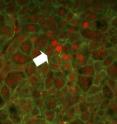New link in liver cancer
Liver damage can be triggered by various insults, including hepatitis infection or alcohol-induced cirrhosis. In severe cases, this damage can lead to cancer. A new study by researchers at the National Institutes of Health and Osaka University reveals how one protein helps decide the fate of damaged livers in mice. The study will be published online on March 30th in the Journal of Experimental Medicine. Liver cells rely on signals triggered by growth hormone to survive and multiply—functions that go haywire in cancer. Normally, growth hormone works by activating a signaling network inside liver cells that includes a protein called STAT5. When the researchers removed STAT5 from liver cells, cancer ensued.
The normally protective effect of STAT5 was traced to its ability to hitch itself to a damage-inducing protein called TGFbeta and trigger its destruction. Without STAT5, TGFbeta levels soared, and growth hormone activated a related protein, STAT3, which is known to promote tumor growth.
TGFbeta and STAT5 appear to be adversaries in the liver, according to the study. STAT5 protects the liver by breaking down TGFbeta. But when TGFbeta is abundant—as occurs in people with chronic liver damage—growth hormone activates the cancer-promoting STAT3 instead of the protective STAT5. These results might help explain how chronic liver damage can eventually lead to cancer.
Source: Rockefeller University Press
Other sources
- New Link In Liver Cancerfrom Science DailyMon, 30 Mar 2009, 14:28:46 UTC
